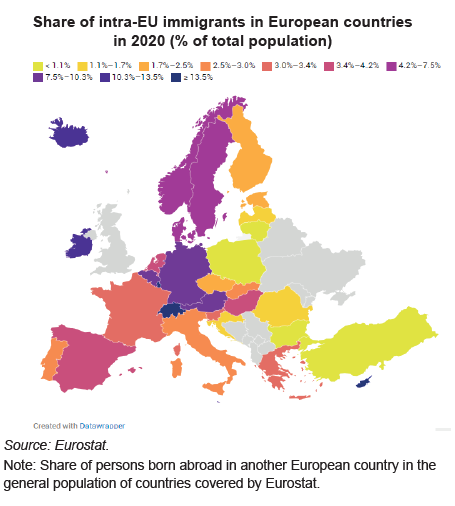Intra-EU Mobility of Persons
The European Union (EU) is building a common market and European citizenship based on the principle of free movement. The EU’s enlargement has allowed for an increase in intra-EU mobility. The removal of barriers to mobility has underpinned labour productivity within the EU and the economic integration of its Member States. There are still obstacles to mobility such as linguistic and cultural differences, and the recognition of qualifications on the labour market.
The goal of the European Union (EU) is to build a common economic market and drive the emergence of an European citizenship grounded in the concept of the free movement of persons, goods, services and capital. Whilst for persons, EU legislation initially covered workers’ mobility, it has been extended to encompass other reasons for migration, in particular for studies under the Erasmus+ programme.
For the purposes of international statistics, an immigrant is defined as a person who lives outside their home country (thus excluding tourism or cross-border commuting). Owing, in particular, to the progressive removal of statutory obstacles, the average share of immigrants in the populations of European countries has more than doubled since 1960, jumping from 4.5% in the current 27 EU Member States to over 11% in 2019. In that year, out of these 11%, 3.7% of EU inhabitants originated from another EU Member State (see Chart). On average, these intra-EU immigrants are more highly qualified and more often in employment than non-EU immigrants.
EU membership leads to a sharp decline in border frictions that could impede the mobility of persons to and from the country. Accession should go hand in hand with an immediate reduction in the formal and informal barriers to the migration of other Europeans to the country in question, which could fall by almost a third a decade after joining.
This removal of barriers to the intra-EU mobility of persons helps ensure the smooth workings of the internal market by providing businesses and workers with fresh opportunities for matching supply and demand which foster the EU’s productivity. The regional and national impact is especially positive when the skills of immigrant workers complement those of nationals, or when immigrants take up unfilled vacancies in certain sectors in the host country.
Despite the removal of statutory barriers to intra-EU mobility, there are still practical barriers such as those relating to language and culture, the issue of the recognition of skills and qualifications on the labour market, and the heterogeneity of social security systems.
